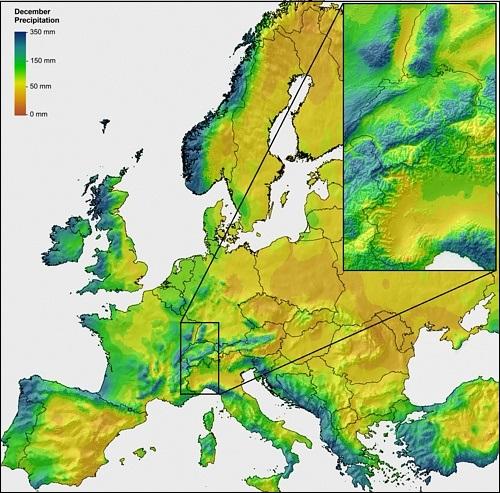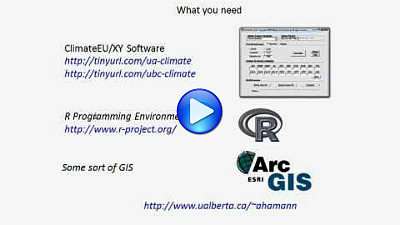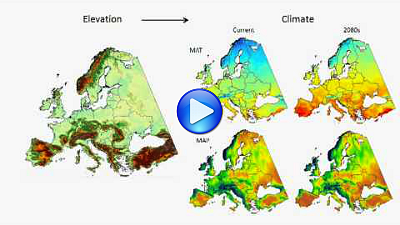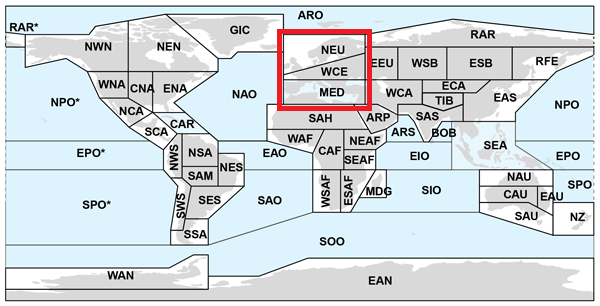 On this page you can download the ClimateEU software and approximately 3,000 climate grids at 1 km resolution (Albers Equal Area projected) or ~2km resolution (75 arcsecond, unprojected). The software can further generate time series data for historical climate (1901-2020) in monthly, annual, decadal, and 30-year steps and projected future climate (2020s, 2050s, 2080s) based on CMIP6 multi-model projections.
On this page you can download the ClimateEU software and approximately 3,000 climate grids at 1 km resolution (Albers Equal Area projected) or ~2km resolution (75 arcsecond, unprojected). The software can further generate time series data for historical climate (1901-2020) in monthly, annual, decadal, and 30-year steps and projected future climate (2020s, 2050s, 2080s) based on CMIP6 multi-model projections.
The database includes monthly base variables (Tmin, Tmax, Tave & Prec) as well as economically or biologically relevant (bioclim) variables such as growing and chilling degree days, beginning and end of frost free period, heating and cooling degree days, Hargrave's climate moisture deficit and reference evaporation, precipitation as snow, and seasonal variables.
The climate grids were developed with a deep neural network that uses geographic and atmospheric information to model local weather patterns. Click on image on the right ( ![]() ) to see a higher resolution version, with the inset showing precipitation induced by orographic lift and rain shadows in the Alps region.
) to see a higher resolution version, with the inset showing precipitation induced by orographic lift and rain shadows in the Alps region.
Subsequently, the ClimateEU software downscales the grids to higher resolutions with a digital elevation model in conjunction with local environmental lapse-rates. The software can also provide scale-free point estimates of climate variables for user-provided latitude, longitude and elevation coordinates.
Video tutorials
Get started with these two video-tutorials. This first video explains the basic functionality of the software (1) interactive query of climate for locations, (2) processing spreadsheets of locations, (3) generating time series of climate, and (4) basic processing of gridded data. The second video explains in detail how to generate continental scale climate grids in projected coordinate systems, and how to automate generation of multiple climate surfaces for a variety of climate variables, historical time periods and future projections.
Software download and references
This software can be used to query climate variables for any location, elevation and time period across Europe. The program does not require installation. Download, unzip, and double click the executable file ClimateEU.exe. The program should run on all versions of Windows. If you receive the error message "COMCTL32.OCX missing", you have to install these libraryfiles. The program also runs on Linux, Unix and Mac systems with the free software Wine or MacPorts/Wine).
We are working on publishing a research note that explains new methods and datasets underlying ClimateEU v5. Meanwhile you can cite as follows: "Climate data has been generated with the ClimateEU v5.00 softwarepackage, available at http://tinyurl.com/ClimateEU, based on methodology similar to Mahoney et al. (2022) and Marchi et al. (2020)."
Gridded data at ~2km resolution (75 arcsec, unprojected)
Help file |
ClimateEU input file |
Elevation, ID reference |
Area covered |
|---|---|---|---|
| Usage, variables, grid generator: |
75 arcsec CSV: |
75 arcsec geoTIFF: |
Shapefile: |
based on a variety of quality criteria and representativeness. For details on GCM selection, see Mahoney et al. (2022).
2) Average projected global warming by the 2080s for different Shared Socioeconomic Pathways (SSP) scenarios:
SSP1-2.6: 1.5-2.0°C; SSP2-4.5: 2.5-3.0°C; SSP3-7.0: 3.5-4.0°C; SSP5-5.8: 4.0-5.0°C.
3) Projections for 30-year normal periods: 2020s: 2011-2040, 2050s: 2041-2070, 2080s: 2071-2100.
*) SSP2-2020s is a good choice to represent current climate (midpoint of "middle of the road" climate normal estimate).
Gridded data at 1km resolution (Albers Equal Area Conic projection)
Help file |
ClimateEU input file |
Elevation, ID reference |
Area covered |
|---|---|---|---|
| Usage, variables, grid generator: |
1 km CSV: |
1 km geoTIFF: |
Shapefile: |
Scenario selection to quantify uncertainty for different Counties and IPCC regions of Europe
If you want to quantify uncertainty in future projections, you need to work with a selection of multiple, individual models. This is easily done with the provided software for locations of interest (see video tutorial above), the pre-selected grids downloadable below, or it is also fairly straight-forward to generate custom grids with the help of some R code (included in the help file) if your data needs are different.
To help with the selection of a representative set of models for different regions of Africa (or for the entire continent), we used the Katsavounidis-Kuo-Zhang (KKZ) algorithm which selects an optimally representative set of future projections for different IPCC climate reference regions considering multiple climate variables (click on left panel dendrogram to visualize similarity among models):
A common approach is to select a median, a pessimistic and an optimistic projection, i.e., a subset size of 3. For example, to assess uncertainty in the United Kingdom and Irlend region (uk/ie) with a 3-model ensemble, you would choose the models: CNRM (median), ACC (pessimistic), and MPI (optimistic) from the table below (compare with the dendrogram above). Adding additional models (rows 4 to 8) will provide increasingly better representation of uncertainty in future predictions in multivariate space.
To include the sensitive "outlier" model UKES in the model selection process, use the lower portion of the table. If UKES is included, this scenario will almost always be picked second, as the most "pessimistic" model of global warming. UKES is not a very likely outcome, but if you work with a larger ensemble, you may include it as one possible outcome. For details on GCM selection process, see Mahoney et al. (2022).
Subset size |
IPCC climate reference region (upper case) / groups of countries (lower case) |
Europe |
||||||||||
|---|---|---|---|---|---|---|---|---|---|---|---|---|
NEU |
WCE |
MED |
uk/ie |
pt/es |
fr/bl/lu |
nl/dk/de |
no/se/fi |
ch/at |
eu-ne |
eu-se |
||
| Excluding UKESM1-0-LL (recommended for smaller ensembles with up to 5 models) | ||||||||||||
| 1 | CNRM | GISS | MRI | CNRM | CNRM | GISS | GISS | CNRM | MRI | MRI | CNRM | CNRM |
| 2 | EC | EC | ACC | ACC | ACC | ACC | EC | EC | ACC | EC | EC | EC |
| 3 | MPI | ACC | MPI | MPI | EC | EC | ACC | MPI | MPI | ACC | ACC | MPI |
| 4 | GFDL | MPI | EC | EC | MPI | GFDL | GFDL | GFDL | EC | MPI | MPI | ACC |
| 5 | MIROC | GFDL | GFDL | GISS | MRI | MIROC | MPI | MRI | GFDL | MIROC | GFDL | GFDL |
| 6 | ACC | CNRM | CNRM | MRI | MIROC | MPI | CNRM | MIROC | GISS | GFDL | MRI | MIROC |
| 7 | MRI | MIROC | MIROC | GFDL | GFDL | MRI | MIROC | ACC | CNRM | CNRM | GISS | GISS |
| 8 | GISS | MRI | GISS | MIROC | GISS | CNRM | MRI | GISS | MIROC | GISS | MIROC | MRI |
| Including UKESM1-0-LL (recommended when using 6 to 13 models) | ||||||||||||
| 1 | CNRM | GISS | MRI | CNRM | CNRM | GISS | GISS | CNRM | MRI | CNRM | MRI | CNRM |
| 2 | UKES | UKES | UKES | UKES | UKES | UKES | UKES | UKES | UKES | UKES | UKES | UKES |
| 3 | EC | EC | MPI | MPI | EC | EC | EC | MPI | MPI | EC | MPI | EC |
| 4 | MPI | ACC | ACC | EC | MRI | ACC | ACC | EC | ACC | MPI | EC | MPI |
| 5 | MIROC | GFDL | EC | GISS | MPI | MIROC | GFDL | GFDL | EC | ACC | GISS | ACC |
| 6 | GFDL | MPI | GFDL | ACC | ACC | GFDL | MPI | MIROC | GISS | MIROC | ACC | MIROC |
| 7 | ACC | MIROC | CNRM | MRI | MIROC | MRI | CNRM | MRI | GFDL | GFDL | MIROC | GFDL |
| 8 | MRI | CNRM | MIROC | MIROC | GFDL | MPI | MIROC | ACC | MIROC | MRI | CNRM | GISS |
| 9 | GISS | MRI | GISS | GFDL | GISS | CNRM | MRI | GISS | CNRM | GISS | GFDL | MRI |
fr/bl/lu: France, Belgium, Luxembourg; pt/es, Portugal, Spain; nl/dk/de, Netherlands, Denmark, Germany; no/sw/fi, Norway, Sweden, Finland;
ch/at, Switzerland/Austria; eu-ne, northeastern European contries - Baltic to Romania; eu-se, southeastern European countries - Italy to Bulgaria;
2) Model abbreviations are: ACC, ACCESS-ESM1-5; CNRM, CNRM-ESM2-1; EC, EC-Earth3; GFDL, GFDL-ESM4; GISS, GISS-E2-1-G; MIR, MIROC6;
MPI, MPI-ESM1-2-HR; MRI, MRI-ESM2-0; and UKES, UKESM1-0-LL.
Below, you can find a table with individual scenario downloads for uncertainty analysis. This is not the full set of SSPs is not typically necessary for a meaningful uncertainty analysis. The selection below will be suitable to quantify medium term (2050s) and long term (2080s) uncertainty in projections, as well as the dependence of outcomes on two SSPs.
Individual GCM downloads for uncertainty analysis
[currently under development - check back in July]
Acknowledgements
This research has, in part, been sponsored by the Alexander von Humboldt foundation and an NSERC Discovery Grant.






